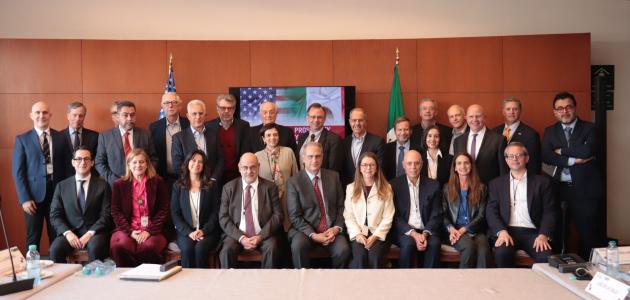The Annenberg Foundation has granted the Hoover Institution at Stanford University $10 million to establish an endowment fund entitled the “Annenberg Strategic Initiative.” The initiative will support public policy development in the areas of economics, national security, and foreign policy in ways that encourage creative efforts and stimulates entrepreneurial instincts among scholars at the Hoover Institution and elsewhere in the university.
“The Hoover Institution is deeply interested in generating ‘ideas defining a free society’—indeed it is a guiding principle within our mission,” said John Raisian, Hoover’s director. “Funds from this magnificent and imaginative endowment will spawn such creative ideas and support those ideas that are especially new, sweeping, and undeveloped. Support of this kind is difficult to obtain in early phases of development. The Annenberg Strategic Initiative will allow scholars a means for taking intellectual risks in addressing new areas of inquiry with new approaches pertaining to important issues of the day.”
An example of such application is a new Stanford project focusing on the possibility of a world free of nuclear weapons. Hoover fellows Sidney Drell (a physicist and expert on nuclear weapons) and George Shultz (President Reagan’s secretary of state) launched an initial conference one year ago, marking the 20th anniversary of the historic meeting in Reykjavik between President Reagan and General Secretary Gorbachev to discuss the possibility of a world free of nuclear weapons.
“The idea never took hold and virtually dropped out of sight,” commented Shultz. “As the problem of nuclear proliferation is now at a tipping point, we thought that this big idea with big consequences should be revived and examined. To launch such an effort required seed money, to see if the effort could sustain a major initiative. And seed money was hard to come by. We got some with personal encouragement from Lee Annenberg [widow of Walter Annenberg]. And this idea has now taken off, as we just held a highly successful follow-up meeting involving numerous experts, including Henry Kissinger, Bill Perry, and Sam Nunn.”
President John Hennessy stated, “We are extremely grateful to Lee Annenberg for her gift, and we are proud that such a distinguished alumna has chosen to support these critical areas of academic inquiry at the Hoover Institution. I look forward to monitoring the creative work in the area of public policy that I'm sure will develop over the next few years as a result of Lee Annenberg's generosity.”
The director of the Hoover Institution will administer the funds with advice from a three-person faculty committee appointed in consultation with the president of Stanford University. The initial committee will be chaired by George Shultz; the other members will be John Taylor and Morris Fiorina. All are senior fellows at the Hoover Institution, with Shultz having an emeritus professorship at the Graduate School of Business, Taylor a joint appointment with the Department of Economics, and Fiorina a joint appointment with the Department of Political Science.
The Annenberg Foundation has made other generous grants to support programs and fellows at Stanford and Hoover. In 2004, the foundation granted Stanford University $5 million to honor former U.S. secretary of state George P. Shultz. Of this, the Hoover Institution received $4 million to endow the position of an Annenberg Distinguished Fellow. The Stanford Institute for Economic Policy Research (SIEPR) received $1 million for the George P. Shultz Dissertation Support Fund that supports empirical research by graduate students working on dissertations oriented toward problems of economic policy.
In 2005, the Hoover Institution dedicated the state-of-the-art Annenberg Conference room in the Lou Henry Hoover Building, using a $500,000 grant from the foundation to create a two-level conference room equipped with cutting-edge audio and video conferencing equipment.
Established in 1989 by Walter H. Annenberg, the Annenberg Foundation provides funding and support to nonprofit organizations in the United States and throughout the world from its headquarters in Radnor, Pennsylvania, and offices in Los Angeles, California. Its major program areas are education and youth development; arts, culture, and humanities; civic and community life; health and human services; and animal services and the environment. In addition, the foundation operates a number of initiatives that expand and complement those program areas. The Annenberg Foundation exists to advance the public well-being through improved communication. As the principal means of achieving this goal, the foundation encourages the development of more-effective ways to share ideas and knowledge.













